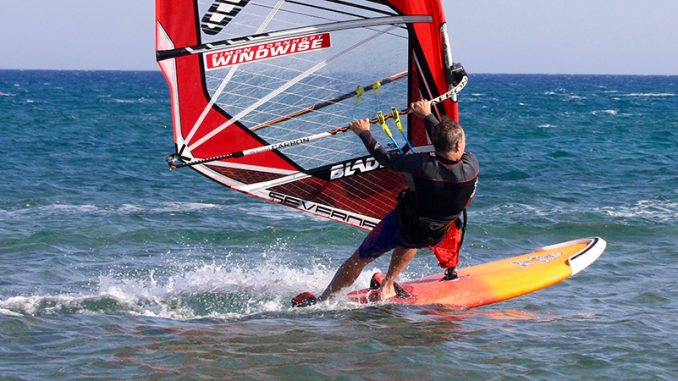
Words and pics: Simon Bornhoft (http://www.windwise.net)
Windsurfing UK is stoked to welcome to fold UK pro windsurfing coach Simon Bornhoft. Simon’s Windwise technique courses have been helping sailors improve, across the globe, for many years. In the first of a new coaching series Mr B imparts valuable knowledge in the hope of getting you to the next level of your windsurfing career.
Over to Simon…
When in coaching mode it takes barely a couple of seconds to identify the exact reason why someone is struggling to achieve their specific windsurfing goal. It could be struggling to ‘back strap’, tack, gybe, coping with challenging conditions or even learn the most complicated move. The ‘reasons’ light up like neon lights, it’s always very obvious, sometimes from hundreds of metres away or before the sailor themselves knows it! The challenge and satisfaction of coaching is identifying the ‘reason’, but far more importantly helping as may people as possible to make the transition from tragedy to triumph.
Fitness, health and attitude influence what we’ll achieve, but realistic progression is possible if you understand how the sport is essentially made up by two guiding principles: a handful of core skills and some very specific actions combining them together. Engage with this ethos and follow the Skills Training System that we’ll passionately role out over the coming months and progression is yours! If not I’ll be your caddy for the day! I say that after having the pleasure of coaching Moira Bastow who, at 85 years young, has learnt to carve gybe a sub 100L board – without a caddy!
This issue our Windwise series outlines the defining factors that help and hinder progression and sets the scene for your improvement. We’ll also give you some homework to try out until next time. So here goes…
1. The blind alley
It’s often said time on the water is key, but I beg to differ. Who’s heard or said, “I’ve been windsurfing for years but still can’t gybe or tack a small board?” Conversely, newbies and those who to find a learning pathway can make big changes in much shorter periods of time. And yes it is possible to cure ‘bad habits’. What counts is what we do with our ‘time on the water’ – just going windsurfing doesn’t make you much better.
2. Windsurfing is too much fun!
Windsurfing, especially when you reach the blast ‘out and back’ stage, feels incredible! Zipping about fine-tuning stance, control or studiously trying 20-30-40 tacks, gybes or whatever lights you up, is great fun, but actually hugely limiting. Say there’s one moment during a crucial skill or move that’s stopping you from succeeding, that ‘moment’ rarely lasts a second or so. That’s say 30-40 seconds per day specific learning time! That’s maybe 20-40-60 minutes per year ‘learning’. Practicing ‘light wind freestyle’ doesn’t do much either. Many can helitack in a Force 2, but they get hammered in anything brisker. I believe lasering in on very specific skills training exercises (light and strong wind) increases ability far more swiftly. Not grasping this concept leads to plateaus or bad habits…
3. Honesty “How do I know if I’m doing it right?”
What we think we’re doing is often not the truth. Whether it’s being videoed or coached, seeing what’s actually going on is crucial for progression. So to remedy this major issue, we’ve developed Windwise ‘Touch Points’ to ‘feel’ and know whether you’re in the game, exaggerating or planing aimlessly down that blind alley.
4. Counter intuitiveness and human nature
Windsurfing is incredibly counterintuitive and human nature often doesn’t help us. When things get tricky we naturally look at what we’re doing’ and pull, hug or get too close to the rig. Both of which instantly destroy the two fundamental principles of windsurfing ‘Vision’ and ‘Opposition’. To overcome human nature we’ll also use Touch Points and Skills Training exercises to develop the proprioception to react intuitively and especially counter intuitively when needed.
Windwise skills training system
1. Key principles
We have two defining principles ‘Vision’ and ‘Opposition’. Whether everyone realizes it or not they form the foundations of pretty much EVERYTHING we do on a board. All that’s written below, plus any ‘tip’ you hear or use should support these two principles. Essentially we should ‘look where we want to go’ and constantly lean, angle or move the body to ‘oppose’ the force, power and movement in the rig. Often it’s exaggerated more than you imagine, sometimes it’s subtle and yes, like all ‘rules’, there are a few times when we break the principle ‘code’ for a particular effect (we’ll say when and why).
2. Core skills
We have a very small selection of core skills, primarily…
- ‘7’ Stance Range – ‘Changing gear’ for early planing, straps, blasting, gybe set-ups/exits and jumps.
- The ‘Warrior’ – specific skills for dry tacks, gybes, helis, wave riding, 360s and optional freestyle.
- Shifting and Switching – specific foot movement for tacks, gybes and helitacks.
- Rig Rotator – hand movement whenever a rig is ‘swung’ or rotated.
We’ll select, train and massively exaggerate the core skill(s) depending on what we’re learning.
3. Skills training exercises
Hugely important are our Windwise Skills Training exercises that reinforce the key principles, develop core skills and massively increase the time spent learning the parts that beach banter or ‘tips’ do not reach.
Extreme upwind downwinders
Combines virtually aspects of every single windsurfing move in ONE exercise.
Clew first beach starts
Crucial for all gybes, wave riding, helicopter tacks and feasible freestyle.
Beach start gybe
Links into rig rotators and is essential if you’re struggling with gybes and even loops.
Warrior uphaul and hover
A stance/action that’s the fabric of dry fast tacks, wave riding, Helitacks, front to sail, 360s and many spinny freestyle moves.
Rig rotator 360
A hand movement for gybes, duck gybes and wave riding.
4. Touch points
Our Windwise touch points are used throughout to keep you ‘honest’, encourage exaggeration and help you ‘feel’ whether you’re getting it right.
Summary
Using Windwise key principles, core skills, skills training exercises and touch points you’ll increase your current learning speed, build interchangeable and linked ‘skills’ to speed up your current and future aspirations.
HOW TO develop your vision touch points with a tack
To finish we’re going to touch on one commonly promoted and simple principle: VISION. But we’ll use a touch point to ensure you know you’re honestly doing it, as human nature forces ‘us’ to look the wrong way. To illustrate this we’ll us a tack, in time you’ll use these touch points all the time.
Key principle vision
Helps us direct body and board, and enables a more stable foot change. Here’s how to sort it the Windwise way!
Skills training exercise purely for vision touch points when tacking
Sail upwind looking forward and putting your chin on your front shoulder (pic 1). Then look back downwind and placing it on your rear shoulder (pic 2). Feel the chin ‘touch’ both shoulders and do it 40-50 times until you feel totally comfortable on any board doing it. We’ve added the Touch Points for hands and feet, but for now focus on CHIN ON SHOULDER and get amazing at it. When tacking you’ll ‘intuitively’ want to look down or at the kit, which is a disaster. Learn to keep your chin on the correct shoulder and you’ll act counter intuitively just when you need to.
We’ll cover fast tacking fully another time, but no matter what ‘style’ you currently use, try this touch point and ask yourself was your chin constantly on that rear shoulder throughout 90% of the tack? You’ll find how ‘chin on shoulder touch point’ is instrumental in sailing upwind, gybing, helitacks, easy wave riding – be it windSUP or wave board – and other whizzy tricks. Simon says: Next month we continue our quest for your windsurfing greatness. In the meantime, any technique queries, questions or suggestions contact [email protected].
Windwise Unique windsurfing experiences combining a proven fast track Skills Training System with welcoming socials and adventures. 2017 UK and OVERSEAS Freeride & Freewave courses and holidays for all levels. [email protected] www.windwise.net

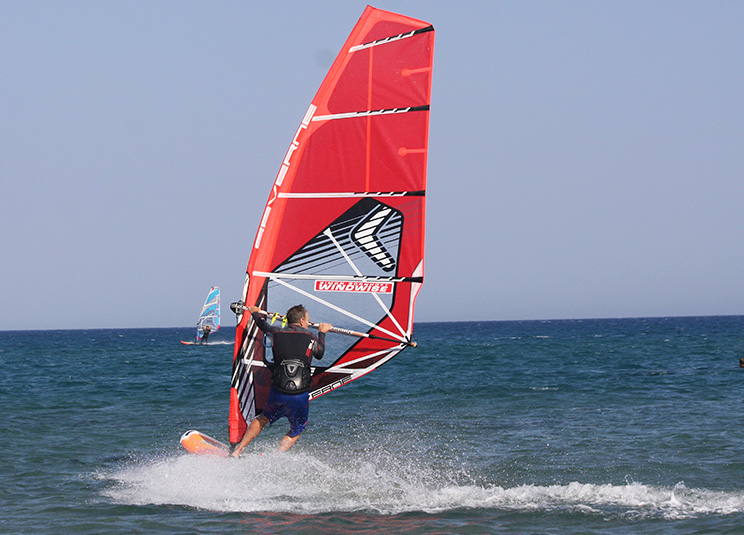







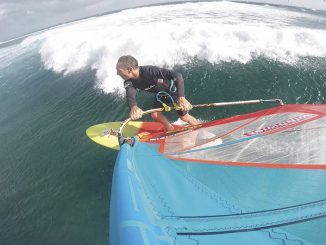
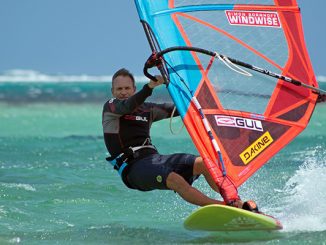
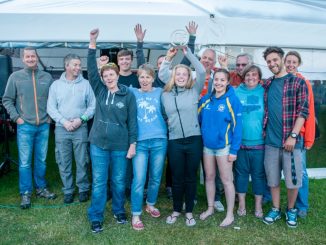
Leave a Reply